Aeneas

Aeneas' Flight from Troy by Federico Barocci (1598)
Borghese Gallery, RomePublic DomainOverview
Aeneas, son of Aphrodite and Anchises, was a Trojan hero who bravely fought against the Greeks during the Trojan War. Though the Greeks eventually sacked Troy, Aeneas managed to escape and settle in the West, where he became the ancestor of the Romans.
Though originally a figure from Greek mythology, Aeneas was wholeheartedly adopted by the Romans, who claimed him as their founding hero. Today, in fact, Aeneas is best known from Roman sources, not Greek ones. These Roman sources fleshed out Aeneas and his mythology, characterizing him as a courageous, long-suffering hero, notable above all for his sense of duty (pietas in Latin).
The Romans worshipped Aeneas under the title “Indiges” or even “Jupiter Indiges.”[1]
Key Facts
Who were Aeneas’ parents?
Aeneas was the son of Aphrodite, the goddess of love and sexuality, and Anchises, a prince and hero from Troy. Aphrodite had fallen in love with the handsome Anchises and seduced him, but she warned him never to reveal that he had slept with a goddess.
According to some sources, Anchises eventually broke that promise, for which he was severely punished: in one well-known tradition, Zeus struck him with a thunderbolt, causing him to become crippled.
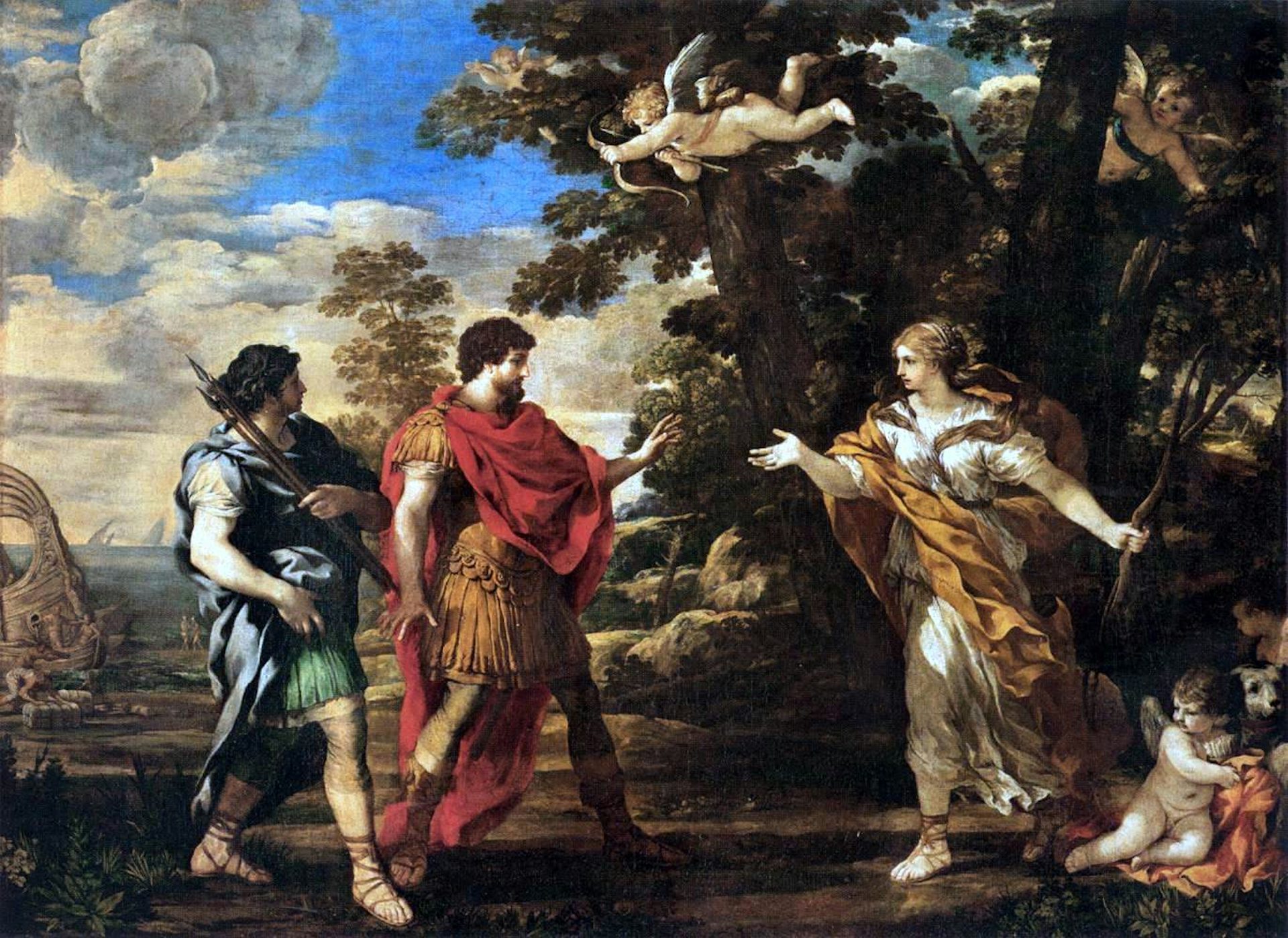
Venus Appears as a Huntress to Aeneas and Achates by Pietro da Crotona (1631)
Wikimedia CommonsPublic DomainWhom did Aeneas marry?
In most accounts, Aeneas’ first wife was a Trojan princess named either Creusa or Eurydice. This wife gave him a son, Ascanius, but died during the sack of Troy.
During his wanderings, Aeneas began a relationship with Dido, the queen of Carthage. However, he was eventually forced to leave Dido so that he could fulfill his destiny of reaching Italy and becoming the ancestor of the Romans.
Once in Italy, Aeneas married Lavinia, the daughter of the Latin king Latinus. To win her hand, Aeneas first had to fight a bloody war against Turnus, another suitor of Lavinia’s, and his army of Latin and Etruscan allies.
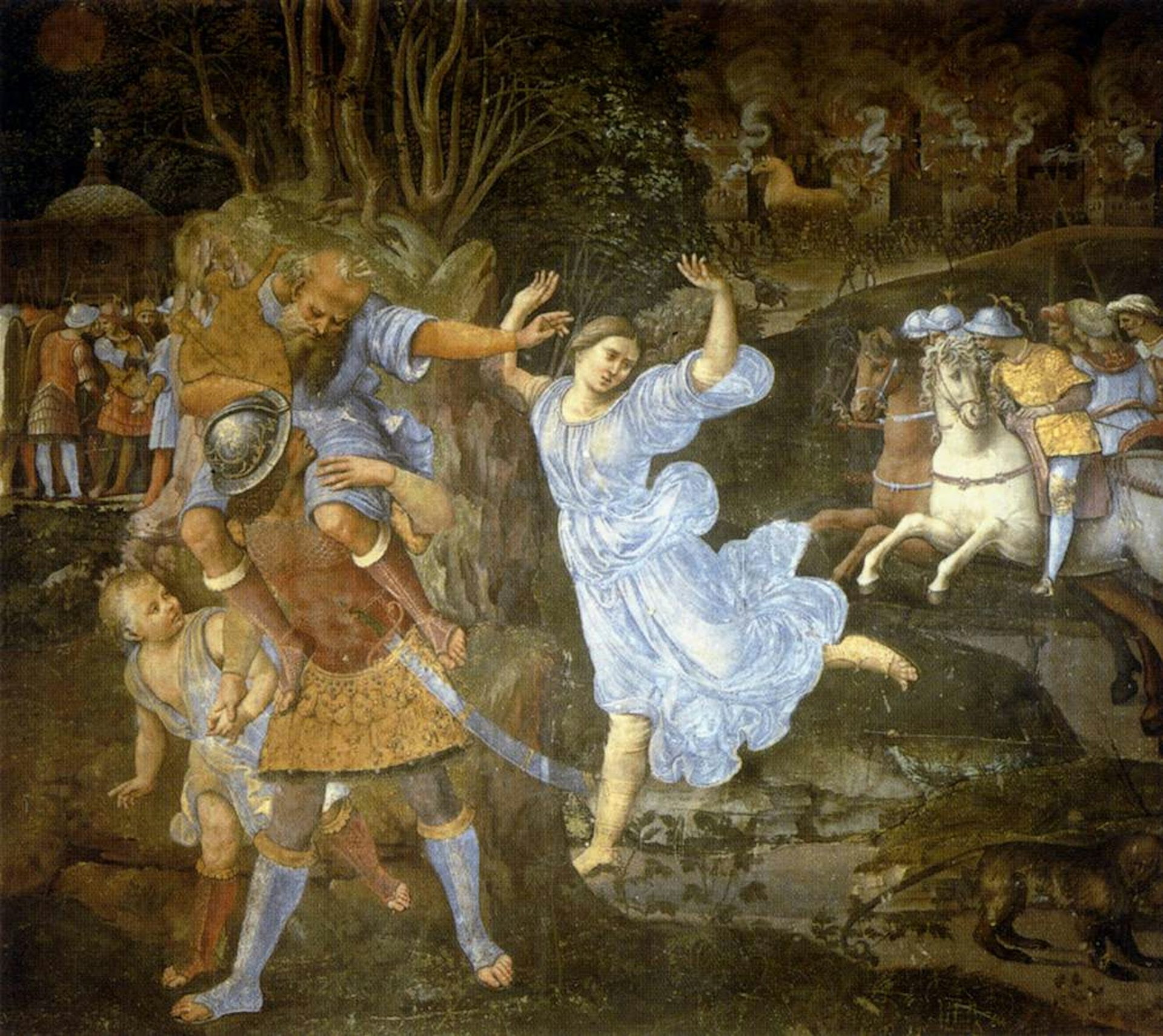
Flight of Aeneas from Troy by Girolamo Genga (between 1507 and 1510)
Pinacoteca Nazionale, SienaPublic DomainWhat city did Aeneas found?
In Italy, Aeneas was usually said to have founded the city of Lavinium, which he named after his new wife Lavinia. Lavinium was located in the central Italian region of Latium.
Aeneas’ Lavinium was one of the mother cities of Rome. After Aeneas died, his son Ascanius took some colonists from Lavinium and founded Alba Longa. Many generations later, the Alban twins Romulus and Remus founded Rome. This is why Aeneas is called the ancestor of the Romans.
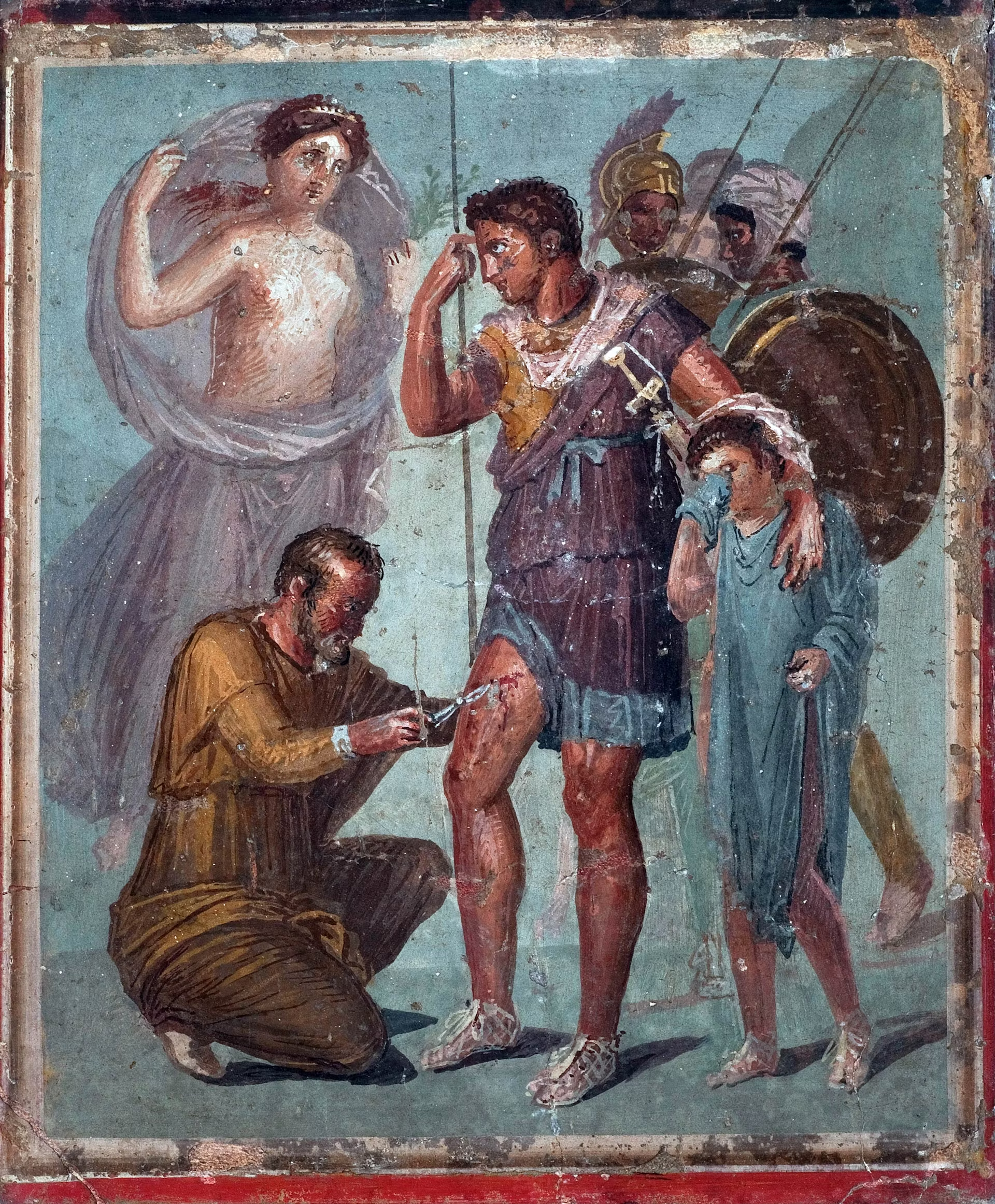
Fresco from Pompeii showing Iapyx (left bottom) removing the arrowhead from the thigh of Aeneas (center) as Iulus (right) and Venus (top left) watch (1st century CE)
National Archaeological Museum, NaplesPublic DomainAeneas in the Trojan War
Though eventually adopted as the founding hero of Rome, Aeneas first appeared in Greek literature and mythology. In Homer’s Iliad, for example, he is described as one of the strongest warriors on the Trojan side.
Though a formidable fighter, Aeneas could not always match the Greek heroes he faced in battle. In one episode, he was badly beaten by Diomedes, a hero from Argos. In fact, he would have been killed if his mother Aphrodite had not intervened.
Later in the war, Aeneas was almost killed by Achilles, though he was again saved by a god. This time it was Poseidon, the god of the sea, who carried Aeneas to safety, telling him that it was his destiny to someday found a second Troy.
The myth of what happened to Aeneas after the fall of Troy evolved over time, acquiring its most familiar form in Virgil’s Aeneid. This Roman epic tells of how Aeneas escaped the city of Troy as it was being sacked by the Greeks, taking with him his elderly father, his son, and his household gods. Aeneas then traveled to Italy, where he fought a terrible war with the local inhabitants before founding a new kingdom.

The Fight between Aeneas and Dionysus by Crispijn van de Passe (1613)
RijksmuseumPublic DomainEtymology
The etymology of the name “Aeneas” (Greek Αἰνείας, translit. Aineías, or Αἰνέας, translit. Ainéas; Latin Aeneas) is uncertain. In antiquity, it was connected with the adjective αἰνός (ainós), meaning “terrible.” Aphrodite supposedly gave her son this name because of the αἰνóν ἄχος (ainón áchos)—the “terrible grief”—caused by knowing Aeneas was mortal and therefore destined to die.[2]
But this etymology, while very influential in antiquity, may or may not reflect reality. Aeneas’ name also recalls the Greek word αἶνος (aînos), meaning “story, praise,” as well as the derivative verbs αἰνέω (ainéō) and ἐπαινέω (epainéō), meaning “to praise.”
It has also been suggested that the name is Thraco-Illyrian—that is, originating in the languages spoken by the Thracian and Illyrian people living northeast and northwest of the Greeks.[3]
Pronunciation
English
Greek
Aeneas Greek Αἰνείας (Aineías)/Αἰνέας (Ainéas); Latin Aeneas Phonetic
IPA
[ih-NEE-uhs] /ɪˈni əs/
Titles and Epithets
As one of the most impressive Trojan heroes in Homer’s Iliad, Aeneas was endowed with a number of equally impressive epithets, including μεγαλήτωρ (megalḗtōr, “great-hearted”), ἄναξ ἀνδρῶν (ánax andrôn, “lord of men”), and the patronymic Ἀγχισιάδης (Anchisiádēs, “son of Anchises”).
The Romans also bestowed many epithets upon Aeneas when they adopted him into their mythology and religion. Some of these were inspired by Greek (especially Homeric) epithets: magnanimus, for instance, is a Latin translation of the Greek μεγαλήτωρ (megalḗtōr, “great-hearted”). Roman authors also gave Aeneas Latin epithets such as bonus (“good”), magnus (“great”), or simply heros (“hero”). But his most important epithets by far were pius (“dutiful”) and pater (“father”), used to characterize the hero in Virgil’s Aeneid and other important Roman works.
Attributes
Kingdoms
Aeneas was a Trojan prince, the descendant (through his father Anchises) of the early Trojan king Ilus (see below). He was thus a member of the royal family of Troy. Aeneas spent his early life in the cities of the Troad and in the areas around Mount Ida, where the goddess Aphrodite had given birth to him.

Photo of the cave of Mount Ida in Crete, where the infant Zeus was said to have been brought up
Henry HartleyCC BY 3.0After the fall of Troy, Aeneas escaped the conquering Greeks and sought a new kingdom. In what eventually became the standard tradition, he sailed to Italy with a band of Trojan refugees and founded the city of Lavinium in the region of Latium. But there were other traditions in which Aeneas established his kingdom in Phrygia, Thrace, or even Greece (see below).
Characteristics
Aeneas was one of the mightiest heroes of the Trojan War. On the Trojan side, he seems to have been regarded as second in ability only to Hector;[4] indeed, the Trojans honored him “even as goodly Hector”[5] and “even as a god.”[6] In Homer’s Iliad, he is one of the Trojan fighters most dreaded by the Greeks.[7]
However, Aeneas was no match for the strongest Greek heroes, and in the Iliad he is nearly killed by both Diomedes and Achilles. Fortunately, Homer’s Aeneas is loved by some of the most important Greek gods; he is protected and healed numerous times by Aphrodite (his mother), Apollo, and Poseidon.
Aeneas’ personal characteristics were further developed by the Romans, who adopted the Trojan prince as their mythical ancestor. In Virgil’s Aeneid, Aeneas’ defining trait is his pietas, a Roman concept that is the origin of the English word “piety”—though it is probably better translated as “communal duty.” Virgil’s Aeneas is thus characteristically known by the epithet pius, “dutiful”; from the very beginning of the Aeneid,he is introduced as a “man notable for his pietas.”[8]
Roman sources, particularly the Aeneid, imbued Aeneas with all the characteristics of a good Roman: “pius” Aeneas was devoted to the gods, his family, and his community. He was also generally presented as in control of his emotions, though he was prone to sudden bursts of murderous rage (see especially the abrupt killing of Turnus at the end of the Aeneid).
Arms and Armor
In Homer’s Iliad, Aeneas rides a chariot led by a remarkable team of horses. The Greek hero Diomedes, who wants Aeneas’ horses for himself, describes the beasts’ divine pedigree as follows:
… they are of that stock wherefrom Zeus, whose voice is borne afar, gave to Tros recompense for his son Ganymedes, for that they were the best of all horses that are beneath the dawn and the sun. Of this stock the king of men Anchises stole a breed, putting his mares to them while Laomedon knew naught thereof. And from these a stock of six was born him in his palace; four he kept himself and reared at the stall, and the other two he gave to Aeneas, devisers of rout.[9]
Aeneas loses these horses, however, when he is defeated in battle by Diomedes.[10]
In Virgil’s Aeneid, Aeneas is given a magnificent suit of armor forged by Vulcan, the smith god himself (the Roman counterpart of Hephaestus).[11] This suit of armor included a crested helmet, a breastplate, a sword, and greaves, but its most notable element was an elaborate shield (in many ways similar to the shield of Homer’s Achilles), decorated with episodes from the history of the Romans:
For these, emboss'd, the heav’nly smith had wrought
(Not in the rolls of future fate untaught)
The wars in order, and the race divine
Of warriors issuing from the Julian line.[12]
Taken in chronological order, the scenes on Aeneas’ shield are: the infancy of Romulus and Remus, the rape of the Sabine women, the death of the traitor Mettius Fufetius, Porsenna’s siege of Rome, the Gallic sack of Rome, the Battle of Actium, and the triumph of Augustus.
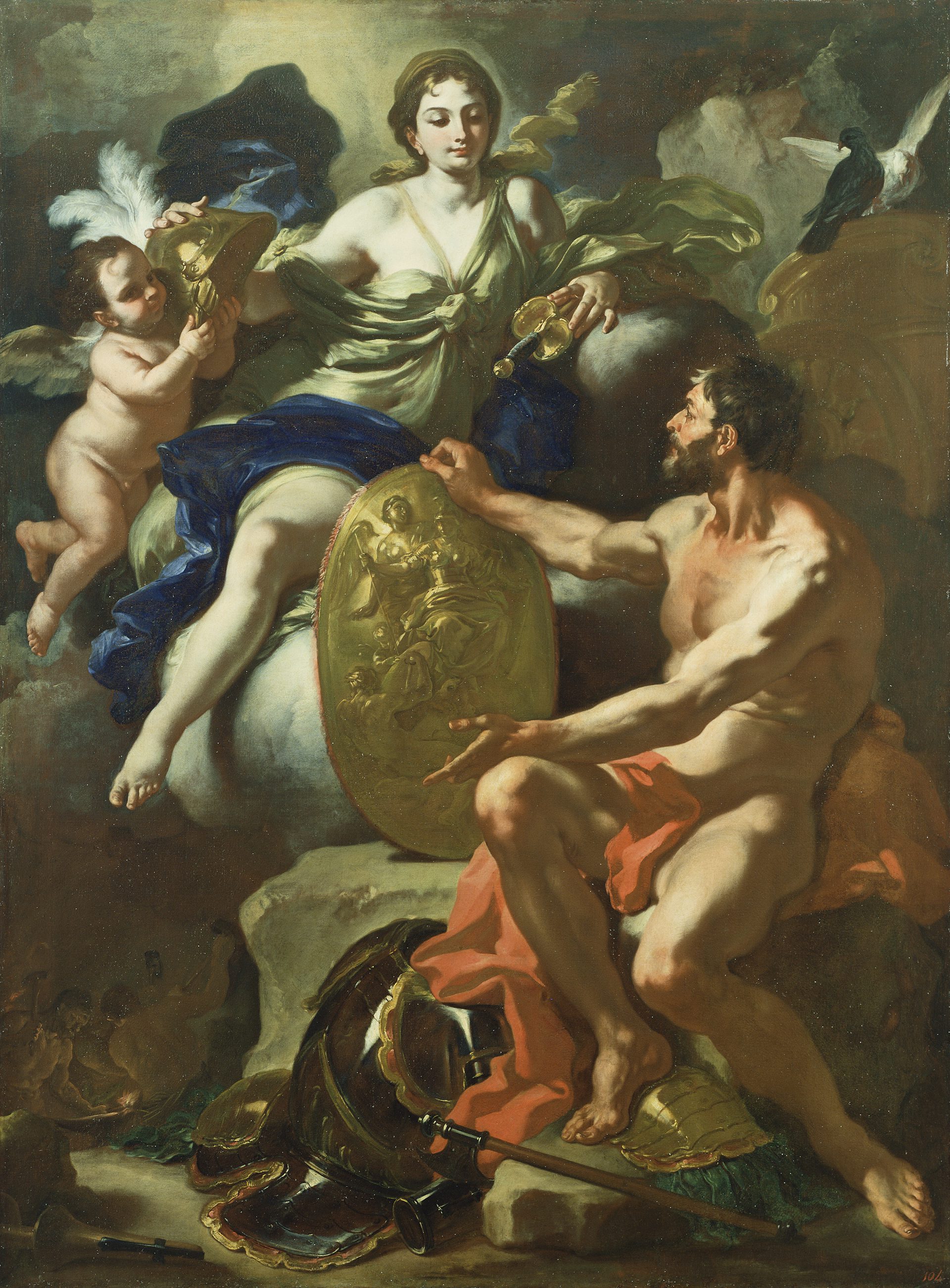
Venus at the Forge of Vulcan (1704) by Italian artist Francesco Solimena. In a sequence from Virgil’s Aeneid, Venus requests a shield and armor for her son Aeneas.
The Paul J. Getty Museum, Los AngelesPublic DomainPhysical Appearance
Early sources do not say much about Aeneas’ appearance. We are presumably expected to imagine him like any other hero: tall, handsome, strong, and the like. Interestingly, even Virgil’s Aeneid—whose protagonist is, of course, Aeneas—says almost nothing specific about Aeneas’ physical features; we are given only a general picture of an appropriately heroic figure, one who is godlike, radiant, strong, and youthful.[13]
Later sources, on the other hand, sometimes set out to give a more specific description of the famous hero. In the History of the Fall of Troy, whose anonymous author (writing around the fifth century CE) claims to be the Trojan priest Dares of Phrygia, Aeneas is described as “auburn-haired, stocky, eloquent, courteous, prudent, pious, and charming. His eyes were black and twinkling.”[14]
Other sources are not so kind. Around the same time (fifth century CE), the Byzantine antiquarian John Malas wrote that Aeneas was short and fat, with a balding head and a ruddy face, but that he also had a powerful build, a strong chest, a good nose, fair skin, a good beard, and gray eyes.[15] Much later, the twelfth-century Byzantine writer John Tzetzes gave a very similar description of Aeneas, making the hero short, fat, and bald, with a big chest, white skin, and large face.[16]
Iconography
In ancient art, Aeneas was represented like any other hero, with an athletic build and armor. The Greeks often depicted him in battle with other heroes of the Trojan War, such as Diomedes or Achilles. From the sixth century BCE on, some vase paintings also showed the scene of Aeneas’ escape from Troy with his father Anchises on his shoulders.
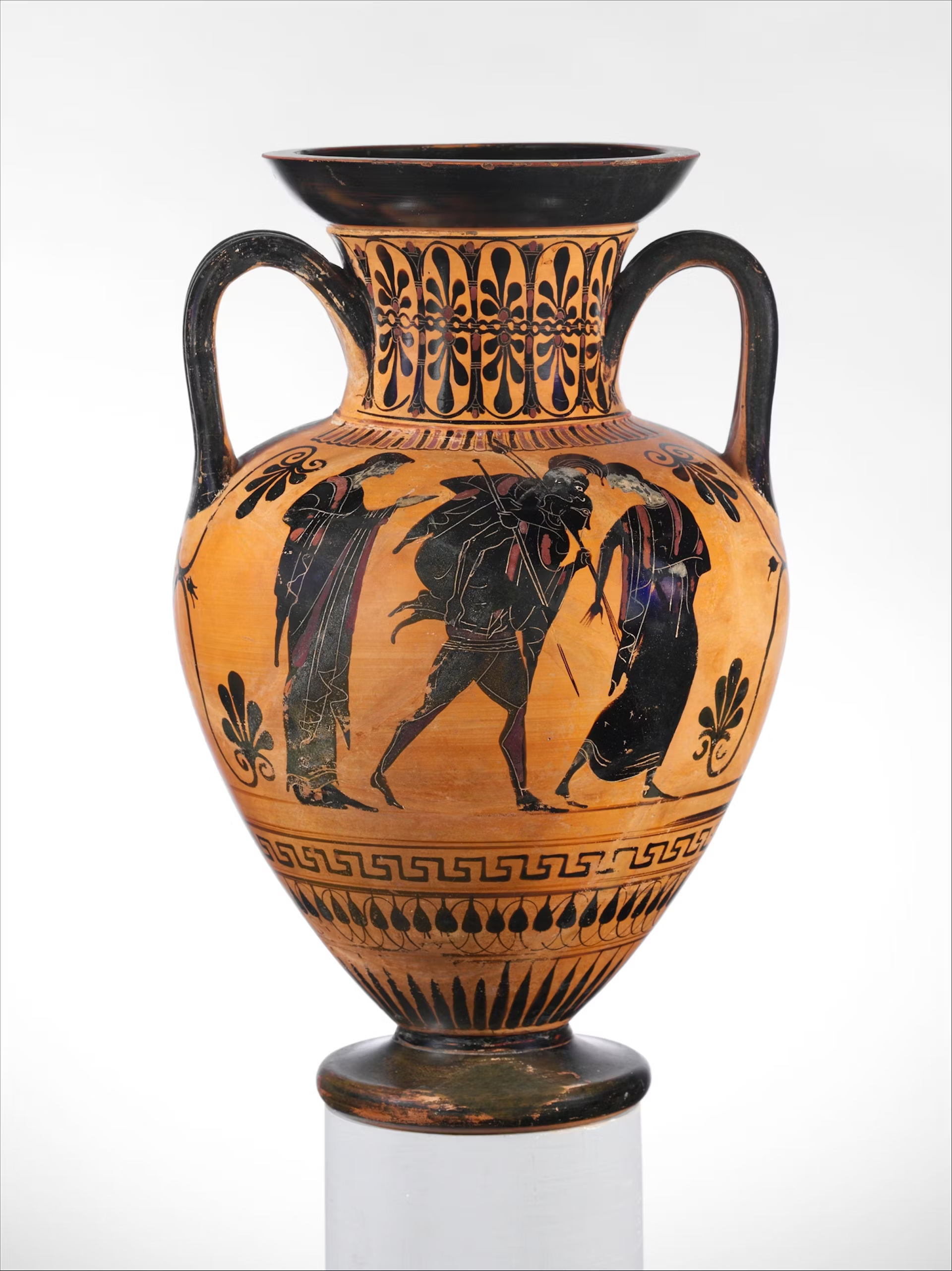
Attic black-figure amphora showing Aeneas carrying Anchises from Troy on his shoulders (last quarter of the sixth century BCE)
The Metropolitan Museum of ArtPublic DomainAs the ancestor of the Romans, Aeneas was an extremely popular subject in Roman painting, sculpture, relief, and mosaic (especially after Virgil composed the Aeneid at the end of the first century BCE).[17]
Family
Family Tree
Mythology
Origins and Early Years
Aeneas was the child of the Trojan prince Anchises and Aphrodite (the Roman Venus), who was the goddess of love. Aphrodite had seen the handsome Anchises caring for his herds on Mount Ida and was immediately smitten. She approached Anchises and became his lover, only later revealing her true identity to him.

Venus and Anchises by William Blake Richmond (1889–1890)
Walker Art Gallery, LiverpoolPublic DomainEventually, Aeneas was born from the union of Anchises and Aphrodite. Aphrodite put her newborn son in the care of the nymphs. When he was five years old, the nymphs brought him to his father Anchises, who took him with him to Troy. Aphrodite warned Aeneas to keep their affair a secret and to introduce Aeneas as the son he had had by a woodland nymph (Anchises, unfortunately, could not resist boasting about his affair and was punished by Zeus).[44]
In Troy, Aeneas was partly brought up by Alcathous, a Trojan warrior who was the husband of his sister Hippodamia (probably the daughter of Anchises by a different woman or by his wife, not by Aphrodite).[45]
The Trojan War
The Beginnings of the War
One of the central events of Aeneas’ life was the Trojan War, the decade-long conflict between the heroes of Greece and the city of Troy. The war began when Paris, one of the princes of Troy (and Aeneas’ cousin), sailed to the Greek city of Sparta on a diplomatic mission and left with Helen, the wife of the Spartan king Menelaus. In one important tradition, Aeneas had accompanied Paris to Sparta.[46]
Menelaus did not appreciate Paris’ seduction of his wife and, with the help of his powerful brother Agamemnon, the king of Mycenae, he amassed a huge army to sail to Troy and bring Helen back.
The Greeks reached Troy. Paris and the Trojans refused to return Helen to her husband, and war began. The Greeks soon began to law waste to the countryside. Aeneas, who like his father had been living as a shepherd on Mount Ida, was forced to abandon his herds and flee from the onslaught of the Greek hero Achilles. He went to Lyrnessus, a city not far from Troy, but was forced away from there as well when the city was sacked by Achilles.[47]
Finally, Aeneas wound up in Troy. There, he helped the Trojans fight against the Greeks, leading the Dardanian warriors together with the sons of the Trojan nobleman Antenor.[48]
Aeneas in the Iliad
Aeneas plays a role in Homer’s Iliad, an epic poem set at the end of the ninth year of the Trojan War. In the Iliad, Aeneas is one of Troy’s bravest and most feared defenders. But Aeneas seems to have borne a grudge against Priam, the king of Troy, and rest of the ruling family, “for that brave though he was amid warriors Priam honoured him not a whit.”[49]
Despite his differences with the rulers of Troy, Aeneas fought bravely against the Greek invaders. Great warrior though he was, Aeneas was repeatedly outmatched by the stronger Greek heroes.
Book 5 of the Iliad tells of how Aeneas set out to do battle with Diomedes, the Greek king of Argos, while he was devastating the Trojan ranks. He rode out to meet him on his chariot, taking with him the Trojan archer Pandarus. Diomedes made quick work of the pair. First, he speared Pandarus in the face. Then, when he and Aeneas leapt from their chariots to meet one-on-one, Diomedes shattered Aeneas’ hipbone with a boulder.
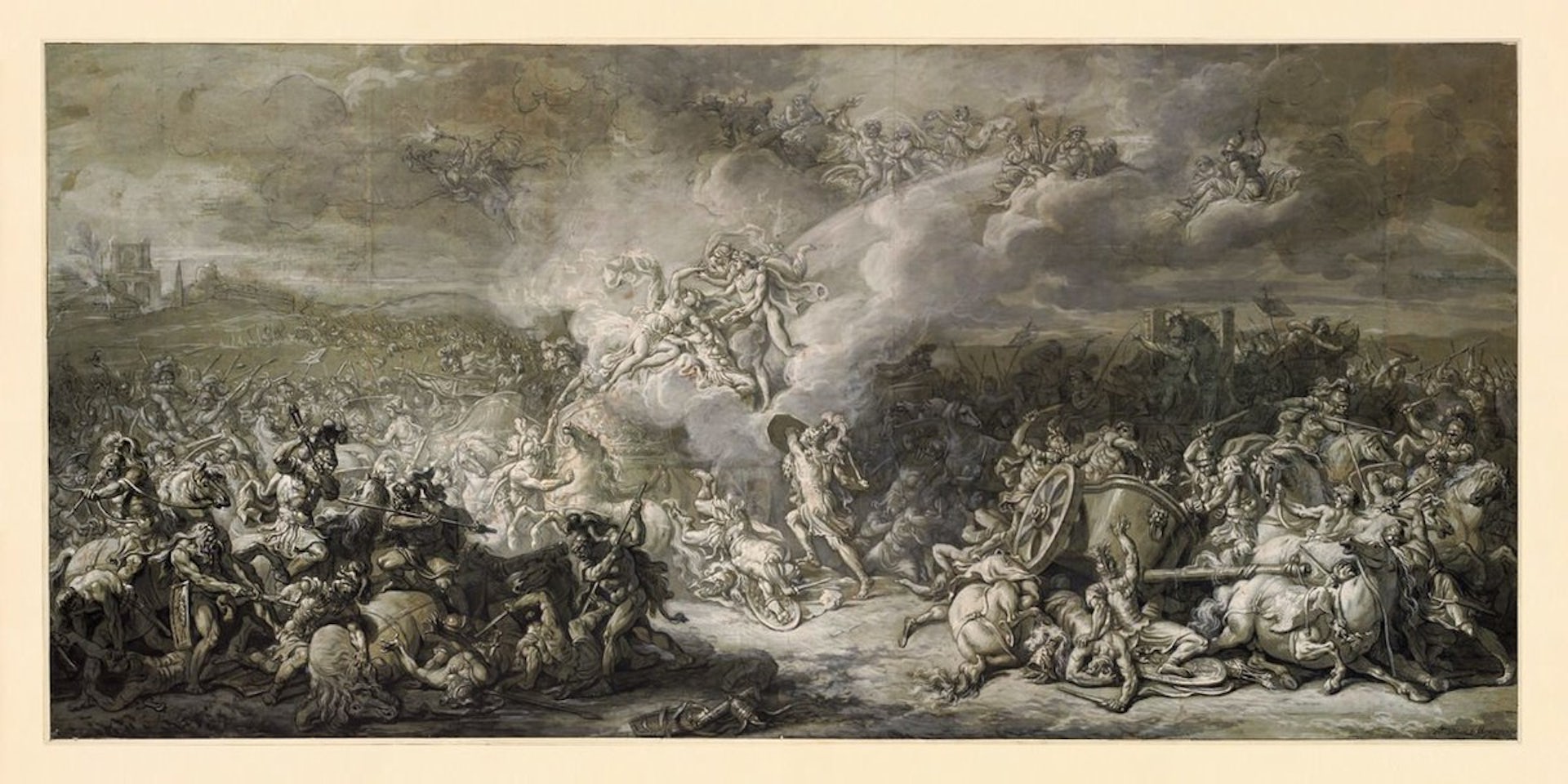
The Combats of Diomedes by Jacques-Louis David (1776)
Wikimedia CommonsPublic DomainBut before Diomedes could deliver the killing stroke, Aeneas’ mother Aphrodite swooped in:
About her dear son she flung her white arms, and before him she spread a fold of her bright garment to be a shelter against missiles, lest any of the Danaans with swift horses might hurl a spear of bronze into his breast and take away his life.[50]
Undeterred, Diomedes thrust at Aphrodite, wounding her on the wrist and causing her to drop Aeneas. But Aeneas was rescued from Diomedes again, this time by Apollo, who snatched him away. Diomedes had to satisfy himself with stealing Aeneas’ divine horses from his abandoned chariot. Aeneas, meanwhile, was healed of his terrible injury by the gods and sent back into battle.[51]
Aeneas appears a few more times over the course of the Iliad. He fights the heroes Menelaus and Antilochus before being beaten back, and later distinguishes himself for his bravery in the Trojans’ attack on the Greek camp.[52]
After Patroclus, the dearest friend of the Greek Achilles, was slain in battle by Hector, Achilles swore vengeance. He set out into battle and slaughtered all the Trojans in his path, choking the plains and rivers with their bodies. Aeneas made a rather ill-advised attempt to check Achilles’ charge.
But Achilles quickly overpowered him and would have killed him had not Poseidon, the god of the sea, arrived to save him (the third time in the Iliad that Aeneas was saved by a god!). Poseidon told Aeneas that he was destined to someday rule over the Trojans.[53]
The Fall of Troy
Aeneas continued to fight bravely for the Trojans for the remainder of the war. Numerous warriors and heroes fell on both sides: Hector, the greatest of the Trojan heroes, was killed by Achilles; Achilles, the greatest of the Greek heroes, was killed by Paris; and the war dragged on.
Eventually, once they had been fighting at Troy for ten years, the Greek hero Odysseus (the king of Ithaca) came up with a clever strategy to take the city: the Greeks built a giant, hollow wooden horse (the “Trojan Horse”) and filled it with their bravest (surviving) heroes. Then the Greek army pretended to retreat, sailing away and hiding on a nearby island.
The Trojans, thinking that they had finally persevered, dragged the horse into the city as a trophy. But at night, when Troy was asleep, the Greeks hidden inside the horse’s belly emerged from a trap door and opened the city gates to the waiting Greek army.
Broadly speaking, there are at least six different versions of what happened to Aeneas during the sack of Troy.
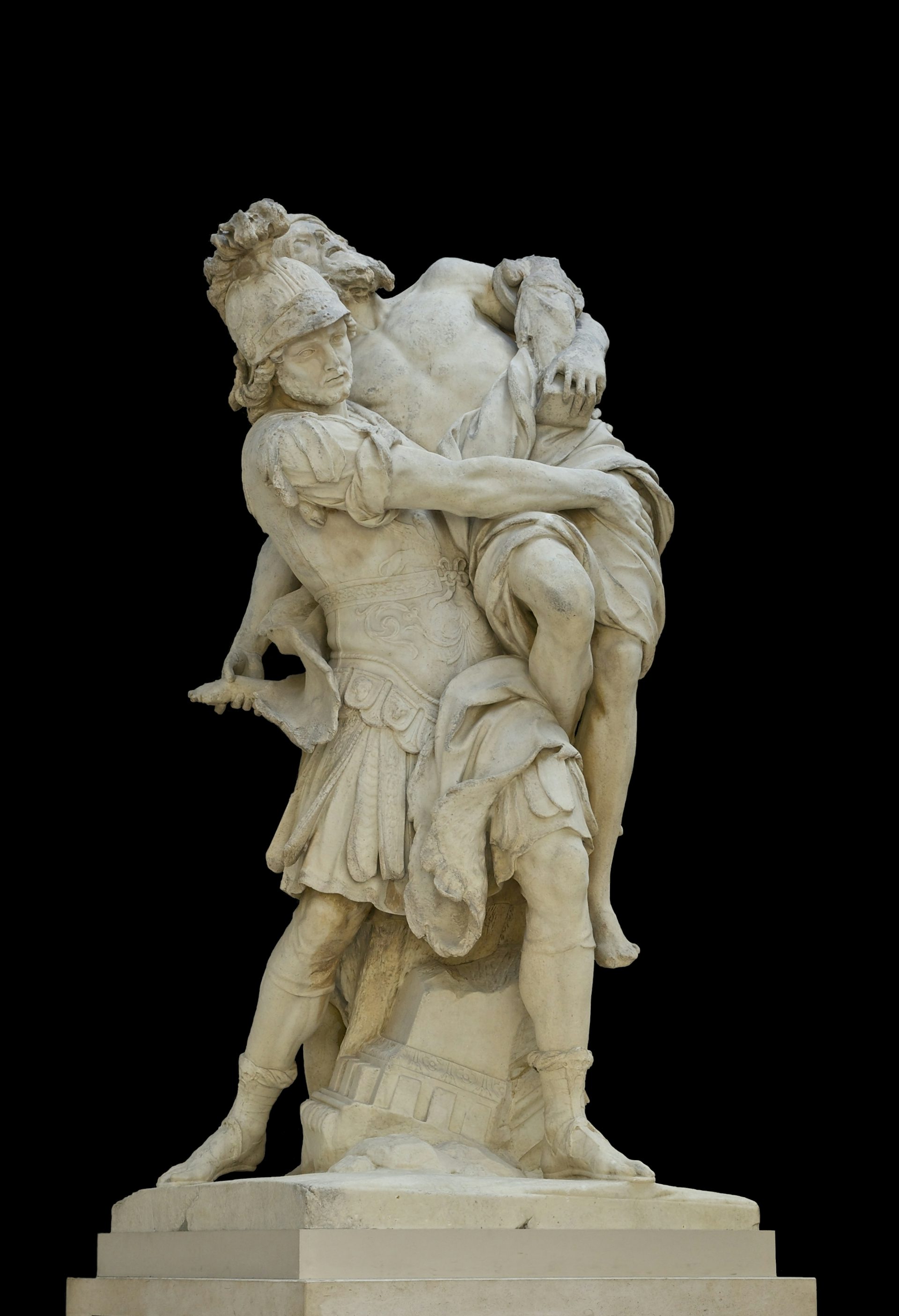
Aeneas and Anchises by Pierre Lepautre (1697)
Louvre Museum, ParisPublic DomainIn what eventually became the standard account—especially after it was detailed at length in Virgil’s Aeneid—Aeneas managed to escape from the burning city with a small band of refugees. Virgil tells of how Aeneas at first led a hopeless resistance against the Greeks who had entered the city before fleeing with his father Anchises, his wife Creusa (other sources call her Euryclea), and his son Ascanius. Though Creusa was lost in the confusion, Aeneas made it out of the city with Anchises and Ascanius.[54]
In what was almost certainly the oldest version, Aeneas actually left Troy before the sack, just as the Trojans were preparing to drag the fateful wooden horse into their walls. As in other versions, Aeneas left the city with his old and crippled father Anchises on his shoulders and accompanied by a group of servants and followers.[55]
In another version, the Greeks were impressed by Aeneas’ piety and bravery and allowed him to leave the city. In one account, the Greeks permitted Aeneas and some of the other refugees to choose one of their belongings to take with them. When Aeneas chose his old father Anchises to carry away on his shoulders, the Greeks were so moved that they let him choose something else too. So Aeneas took his household gods.[56]
In one version, Aeneas did not escape at all. Rather, he was one of the Trojans taken captive by the Greeks. Together with Andromache, the widow of his cousin Hector, Aeneas went to Greece as the slave of Achilles’ son Neoptolemus.[57]
In yet another surprising version, Aeneas was actually the one who betrayed the city of Troy to the Greeks. According to this tradition, it seems that Aeneas felt that he had been dishonored by the Trojan ruling family (as in Homer’s Iliad). To save himself and his family, he thus decided to deliver Troy to the Greeks.[58]
Finally, there appears to have been one tradition in which Aeneas was simply not at Troy at the time of the sack, having been sent away on some assignment (either to check on the Trojan navy or to carry out some military expedition).[59]
The Adventures of Aeneas
The Aeneid
Today, the best-known account of Aeneas’ travels after leaving Troy comes from Virgil’s great Roman epic, the Aeneid. Virgil recounts how Aeneas left the city of Troy as it was being sacked by the Greeks, taking with him his father Anchises, his son Ascanius, and his household gods (his wife, Creusa, was lost in the confusion). Aeneas then built a fleet of ships and, together with a band of Trojan refugees, set out to build a new kingdom.
For several years, Aeneas and the other Trojans sailed the Mediterranean. They first stopped at Thrace, just across the strait from Troy, but were warned to leave by the ghost of the Trojan prince Polydorus, who had been treacherously murdered by the local king. At Delos, they learned from Apollo’s oracle that they were to make their new home in the land of the ancestors. Anchises interpreted this as a reference to the island of Crete, the home of their ancestor Teucer. But this interpretation was proven to be incorrect when the Trojans built a settlement on Crete only to be devastated by plague, a clear omen from the gods that they were on the wrong path. Aeneas then discovered that the oracle referred not to Crete but to Italy.
The Trojans continued their travels. At the Strophades, they had a violent encounter with the vicious Harpies, who foretold further sufferings for them. At Buthrotum, they found two other survivors of the sack of Troy—Hector’s widow Andromache and the seer Helenus. Helenus told Aeneas more about his destiny and his journey. In Sicily, they met Achaemenides, a Greek soldier in Odysseus’ army who had been left behind when Odysseus fled the Cyclops Polyphemus. At Drepana, Anchises died of old age.[60]
The Trojans were then driven by a storm to Carthage. There, Aeneas and the Trojans received hospitality from Dido, the queen of the young city. Aeneas’ mother Aphrodite—Venus to the Roman Virgil—soon caused Dido to fall in love with her son. Aeneas and Dido became lovers. But their bliss was not to last. The gods reminded Aeneas that his destiny lay in Italy, not Carthage, and Aeneas and his companions dutifully returned to sea. Dido, abandoned and forlorn, killed herself.[61]
After leaving Carthage, Aeneas and his men made another stop on Sicily. The king Acestes received them generously. During their stay, however, some of the Trojan women, tired of their wanderings and goaded by Aeneas’ enemy Juno (the Roman Hera), set fire to the ships. After putting out the fire, Aeneas allowed the oldest of his followers to stay behind in Sicily with Acestes.[62]
The Trojan left Sicily for the second time and reached the coast of Italy at last. At Cumae, Aeneas, guided by the Sibyl, visited the Underworld to speak with the shade of Anchises and to learn from him about the destiny of his descendants.[63]
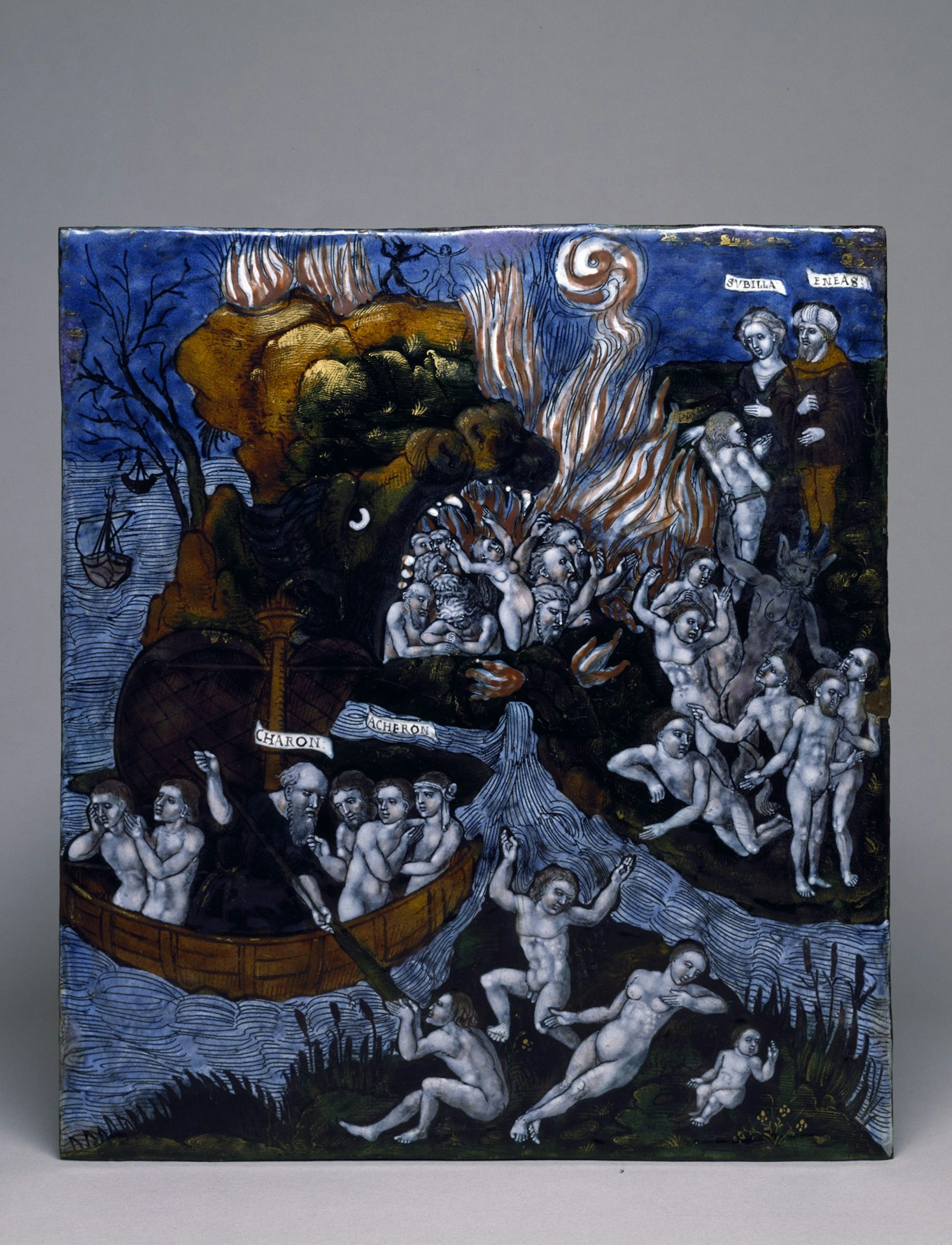
The Descent of Aeneas into Hell by the Master of the Aeneid Legend (ca. 1530–1540)
The Walters Art MuseumCC0After Aeneas’ return from the Underworld, the Trojans sailed further north, to Latium. The local king, the wise old Latinus, welcomed the newcomers and even offered Aeneas his daughter Lavinia’s hand in marriage after learning from an oracle that Lavinia was to marry a foreigner. But Juno, unwilling to leave Aeneas in peace, interfered again, turning Latinus’ wife Amata, Lavinia’s suitor Turnus (the ruler of the Rutulians), and the Latin people against Aeneas and the Trojans. It was not long before tensions erupted into all-out war, despite the protests of Latinus.[64]
Turnus amassed a large army of Italian peoples and led them against the Trojans. Aeneas, meanwhile, went to secure the assistance of the Etruscan king Tarchon and the Arcadian Evander. Turnus took advantage of Aeneas’ absence and attacked his camp, with heavy casualties on both sides. At nightfall, two Trojans, Nisus and Euryalus, try to get past the Italians’ siege to fetch Aeneas. Though they were able to slaughter many of the enemy as they slept, they were finally killed themselves.[65]
Aeneas returned and there was more fighting. Turnus killed Evander’s young son Pallas. Aeneas responded by killing Turnus’ ally Mezentius, an exiled Etruscan king, and his noble son Lausus. After a truce to bury the dead, there was another battle with even more casualties.[66]
At last, Turnus and Aeneas decided to settle the war through single combat. But before their fight could take place, Turnus’ sister Juturna caused the Italians to break the truce. In the confusion, Aeneas found himself wounded with an arrow. But he was soon healed with Venus’ help and returned to fight in the battle that had broken out.
Now the Trojans began to gain the upper hand. Inside the city, the panicked Amata killed herself, thinking Turnus already dead. On the battlefield, Aeneas finally met Turnus in single combat. Aeneas made quick work of him and wounded him in the thigh. Though initially intending to spare his life, Aeneas flew into a rage when he remembered how Turnus had killed Pallas. The Aeneid ends with Aeneas driving Turnus through with his sword.[67]
Other Traditions
Aeneas in Italy
Though Virgil’s account of Aeneas’ travels and arrival in Italy was to become by far the most familiar version of the story, it was certainly not the only version that existed. It was not even the earliest version, though it was certainly known by the third century BCE and may have even been known as early as the sixth century BCE.[68]
Even among the sources that, like Virgil’s Aeneid, had Aeneas settle in Italy, there was a great deal of variation. Besides Virgil, the fullest accounts of this tradition come from Dionysius of Halicarnassus’ Roman Antiquities and Livy’s Histories, both of which differ in many respects from Virgil’s Aeneid and from each other.
Dionysius of Halicarnassus
According to Dionysius of Halicarnassus’ Roman Antiquities, Aeneas stopped at numerous sites across the Mediterranean, almost always leaving temples to his mother Aphrodite in his wake. Dionysius’ Aeneas stops at Pallene (where he founds the city of Aenea), Delos, Cythera (where he founds the city of Cinaethion), Zakynthos, Leucas, Actium, Ambracia, Buthrotum (where he meets Helenus, as in the Aeneid), Onchesmus, Apulia (where some of Aeneas’ followers split up), Drepana (where the Trojans are entertained by Acastus and build the cities of Acesta and Elyma), Campania (where Cape Palinurus, Leucosia, Misenum, Prochyta, and Ceieta are named after various Trojans), and, at last, Laurentum in central Italy.
Upon arriving in Laurentum, Aeneas received certain signs from the gods telling him that this is where he should settle down. He then made an alliance with the local king Latinus, helped him defeat the Rutulians, married his daughter Lavinia, and founded the city of Lavinium. After the death of Latinus, Aeneas succeeded him as king of Laurentum. He then fought the Rutulians for another seven years or so, defeating Turnus (or Tyrrhenius in Greek) before finally being killed in battle against the Etruscan king Mezentius.[69]
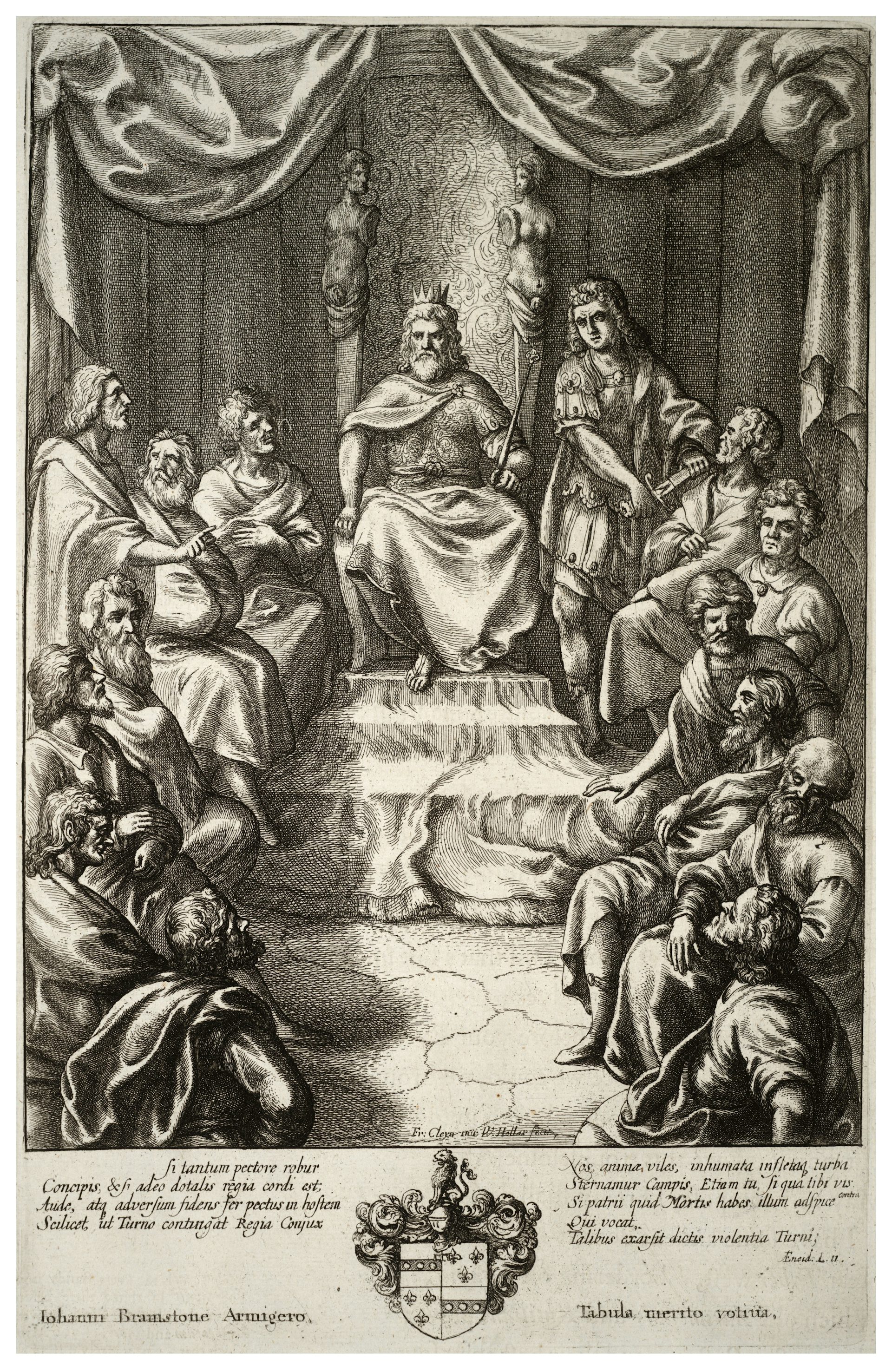
King Latinus in Council by Wenceslas Hollar (17th century)
Thomas Fisher Rare Book Library, University of Toronto, Toronto, ONPublic DomainLivy
According to Livy’s Histories, Aeneas departed from Troy unharmed (the Greeks let him go), after which he traveled to Macedon, Sicily, and finally Laurentum. There, he and his followers raided the territory for a while until the local king Latinus sent out an army to meet them. Aeneas then either defeated Latinus in battle or managed to come to a nonviolent diplomatic settlement (Livy claims to know of two versions). In any case, the Trojans and Latins went on to become allies. Aeneas married Latinus’ daughter Lavinia, founded Lavinium, and had a son named Ascanius.
Soon, war broke out with the Rutulians. In a violent battle, both the Rutulian leader Turnus and the Latin king Latinus were killed. Aeneas then took the throne and continued the war. Eventually the Rutulians were joined by the Etruscan Mezentius and Aeneas fell in battle by the River Numicius.[70]
Others
In short, the standard Roman account—known in somewhat varying forms from Virgil, Dionysius of Halicarnassus, and Livy—seems to have involved Aeneas traveling to Laurentum in Italy, making an alliance with Latinus, fighting the Rutulians, marrying Lavinia, and founding a city called Lavinium.[71]
But sources also differed widely on the details of Aeneas’ journey to Italy. We have already seen that, though there were many similarities between the way Virgil, Dionysius of Halicarnassus, and Livy presented Aeneas’ journey, there were also significant differences between them.
In other authorities, we find further differences in the myths surrounding Aeneas’ journey to Italy. Aeneas’ famous stop at Carthage, for instance, appears to have been known to a few important writers.[72] But in one tradition it was Dido’s sister Anna rather than Dido who was Aeneas’ lover,[73] while in another Dido killed herself not because of Aeneas but because of her African suitor Iarbas.[74]
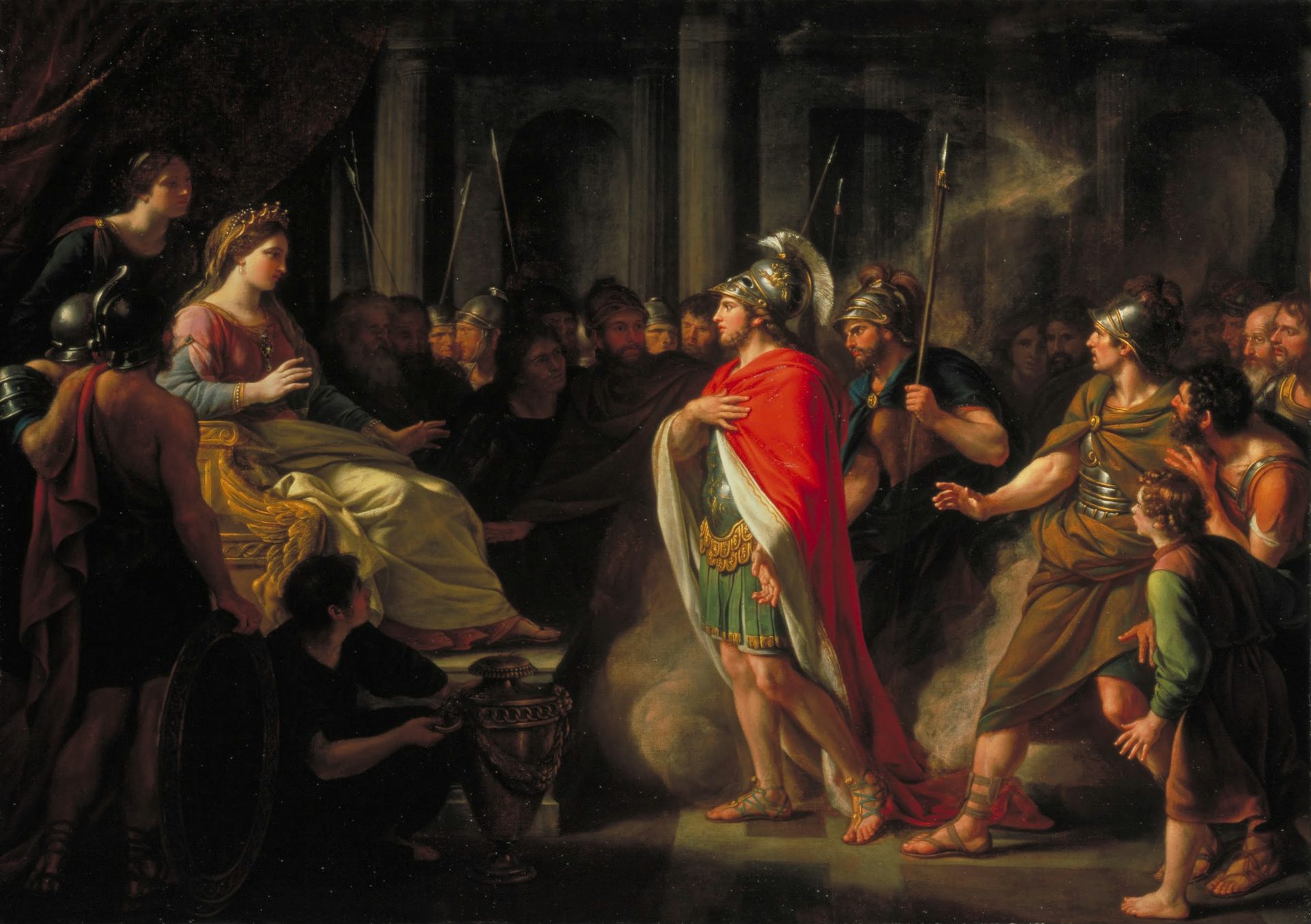
The Meeting of Aeneas and Dido by Sir Nathaniel Dance-Hollard (1766)
Tate Britain, LondonPublic DomainOthers said that Aeneas came to Italy after stopping in Arcadia;[75] that he had founded the city of Pergamum on Crete before being driven away by plague (compare the Aeneid);[76] that while he was in Sicily he founded Segesta[77] or took over the cities of Eryx and Lilybaeum;[78] that some of Aeneas’ followers settled down in Sardinia rather than Latium;[79] and so on. The burning of the ships by the Trojan women was also a familiar episode (though not all authorities agreed in attributing the episode to the myth of Aeneas).[80]
Aeneas as Founder of Rome
In most of the traditions that took Aeneas to Italy, Aeneas was the ancestor of a line of Italian kings who ruled in Lavinium and Alba Longa for several generations. Eventually, one of Aeneas’ descendants, the princess Rhea Silvia, lay with the war god Mars (the Greek Ares) and gave birth to Romulus, the founder of Rome.
But some traditions made Aeneas himself the founder of Rome, or at least shortened the span of time that passed between his arrival in Italy and the foundation of the eternal city.
In one somewhat alarming tradition, Aeneas came to Italy from the land of the Molossians with none other than Odysseus, the mastermind behind the fall of Troy. Together, Aeneas and Odysseus founded Rome, which they named after Rhome, a Trojan woman who had accompanied them on their journey and who burned their ships when they arrived in Latium in order to put an end to their wanderings.[81]
In another tradition, Aeneas founded Rome after he founded Lavinium;[82] in another, he and the Arcadian king Evander renamed the city of Valentia, which already existed on the site, as “Rome;”[83] in another, Aeneas founded Rome by himself and named it after his wife Rome.[84]
Finally, there were a handful of sources that claimed that Rome was founded not by Aeneas but by one of his sons or grandsons.[85]
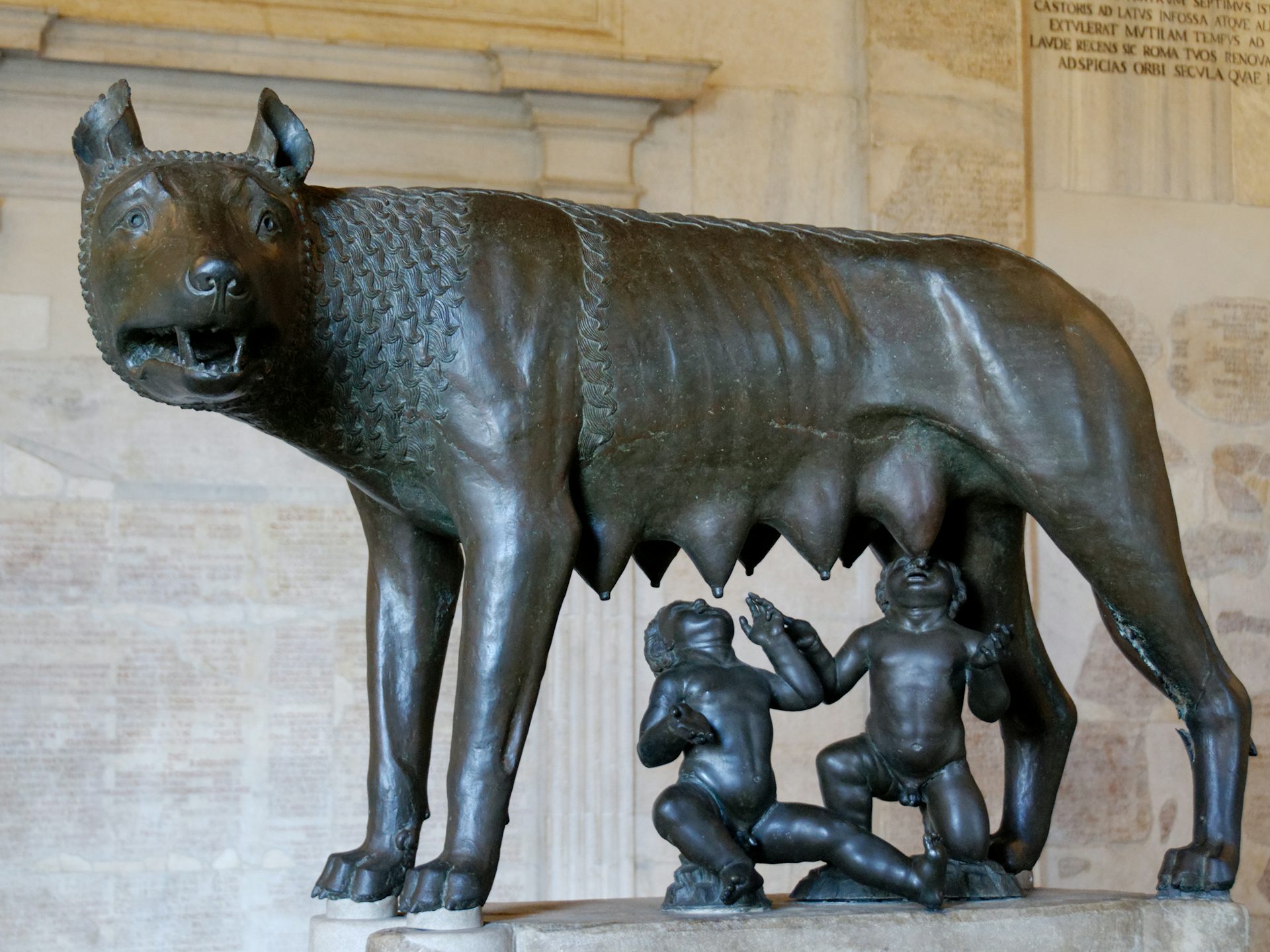
The “Capitoline She-Wolf,” created in the 12th or 13th century; the twins (representing Romulus and Remus) were added later, around the 15th century
Capitoline Museums, Rome / JastrowPublic DomainAeneas in Asia
In some accounts, Aeneas founded his new kingdom not in Italy but in Asia, near to or even on the same spot where the original Troy had stood. This seems to be the tradition implied by our earliest sources for the Aeneas myth.[86] In some traditions, Aeneas did sail to Italy after the fall of Troy but finally returned to Asia to rule over Troy.[87]
Aeneas in Thrace and Macedon
In other accounts, Aeneas founded his kingdom in the northern Balkans, just north of the Greek cities. According to the historian Hellanicus, Aeneas and the Trojans settled the city of Pallene in Thrace, while Aeneas’ son Ascanius stayed behind in Anatolia to settle Dascylium in Mysia.[88] Others claimed that Aeneas settled some other site in the region, such as Samothrace or Aenos[89] or Olympus in Macedon.[90]
Aeneas in Arcadia and Laconia
In some accounts, Aeneas even settled in Greece, in the region of Arcadia. Some said that he first came to Orchomenus and that he then founded the city of Capyae (or Caphyae), which was named after a Trojan named Capys.[91]
In another tradition, Aeneas wound up in the Peloponnesian region of Laconia. There he had a daughter named Etias, after whom the town of Etis was named.[92]
The Death and Apotheosis of Aeneas
In what ultimately became the common tradition, Aeneas died some years after reaching Italy. He fell in battle while fighting an enemy (usually the Rutulians or Etruscans or both) near the Numicius, a river not far from Rome. But Aeneas’ divine mother had arranged for her son to become a god.
In his Metamorphoses, Ovid describes how Venus (Aphrodite) descended from heaven when Aeneas fell into the Numicius, commanding the river to wash away her son’s mortality. The river obeyed:
The horned flood with glad attention stands, Then bids his streams obey their sire’s commands. His better parts by lustral waves refin’d, More pure, and nearer to aetherial mind; With gums of fragrant scent the Goddess strews, And on his features breathes ambrosial dews. Thus deify’d, new honours Rome decrees, Shrines, festivals; and styles him Indiges.[93]
And so Aeneas’ apotheosis—that is, his transformation into a god—was complete.[94]
As we have seen, of course, not all sources agreed that Aeneas came to Italy after the sack of Troy. Naturally, then, not all sources agreed that Aeneas died in Italy. Some, for instance, said that Aeneas settled down in Thrace and ultimately died there,[95] or that he died and was buried in the Troad.[96]
Aeneas between Greece and Rome
Few figures can lay claim to a mythology as complex and dissonant as that of Aeneas. This is in large part because Aeneas was an important figure to both the Greeks and the Romans.
In fact, Aeneas’ mythology evolved over an extremely long period of time: Aeneas first appears in the Homeric epics, which were composed around 800 BCE but which preserved oral traditions that were much older. The myth of Aeneas then appears to have reached Italy through Etruria by around the sixth century BCE, where it continued to evolve.[97] By the fourth or third century BCE, Aeneas was picked up by the Romans, who connected his myth with that of their own founding father Romulus.[98]
The myth of Aeneas—especially the myth of Aeneas in Italy—appealed to different kinds of people and groups of people. Of course, it appealed to the Romans who wished to trace their ancestry to the Greeks, whose civilization they greatly admired. But the myth also appealed to Greeks (like Dionysius of Halicarnassus) who wanted to prove that the Romans—who by 31 BCE had conquered all of the Greek world—were in fact Greeks themselves.
Finally, the myth was of particular interest to Augustus, who became the first “emperor” of Rome in 27 BCE. Augustus was a member of the Julian clan—the gens Iulia—that traced their descent to Aeneas’ son Iulus (also known as Ascanius). By turning Aeneas into a Roman “national hero,” Augustus cemented his own legitimacy as a ruler. This was no doubt part of the reason that Augustus and his political allies encouraged Virgil to compose the Aeneid.[99]
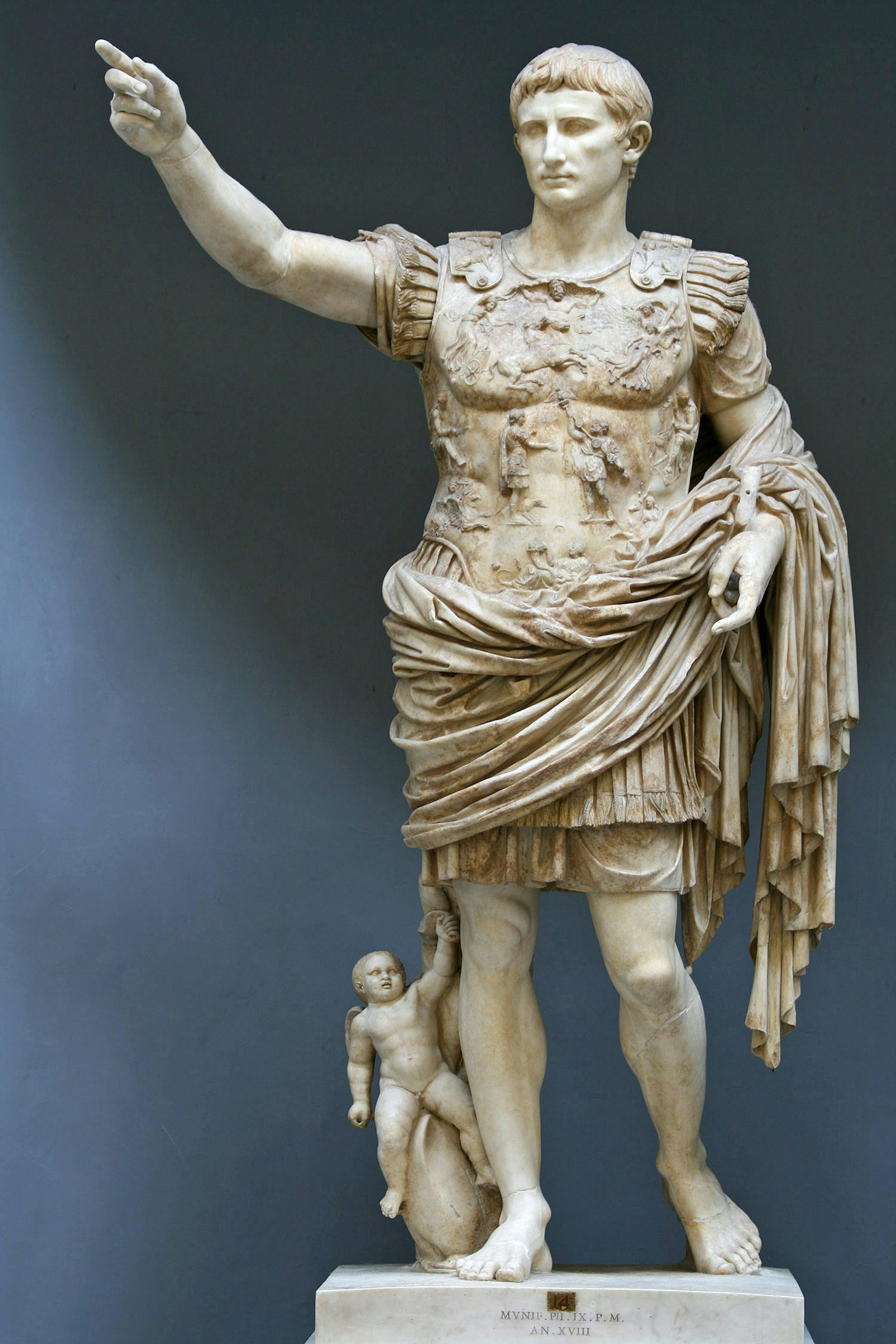
The so-called “Augustus of Prima Porta,” a late-1st century BCE statue of Augustus discovered at the villa of the empress Livia in Prima Porta in Rome
Vatican Museums, VaticanPublic DomainWorship
The worship of Aeneas—as a hero as well as a god—seems to have been known in Asia Minor, on the site of Troy, from an early period.[100] There, the family of Aeneas, the Aeneadae, claimed hereditary privileges for many centuries.[101]
But information on the cult of Aeneas in antiquity is very sparse and unsatisfactory. Aeneas was worshiped in the various sites that traced their origins to him.[102] There is some evidence that the cult of Aeneas reached Sicily from Greece and the results of excavations at the site of Lavinium suggest that his cult may have even traveled as far as central Italy by the fourth century BCE; however, this is far from certain.[103]
Many tombs of Aeneas were known in antiquity, in many different places.[104] This is hardly surprising given the many diverse traditions about where Aeneas ended up. Perhaps the most famous tomb was—or became—the tomb of Aeneas on the River Numicius, where the hero was said to have fallen according to the prevailing Roman tradition.[105] But Aeneas also had tombs in other places, such as Berecynthia in the Troad.[106]
Aeneas received cult honors at his tombs as well. In fact, Aeneas’ Roman cult appears to have been centered upon his tomb at the River Numicius, where he was worshiped under the name of Jupiter Indiges, the “Native Jupiter.”[107]
Pop Culture
Aeneas’ presence in modern pop culture is almost entirely shaped by Virgil’s Aeneid. Aeneas is particularly popular in Italy, where he has inspired films such as The Avenger (1962) and the TV series Eneide (1971–1972).
Aeneas often appears in contemporary adaptations of the Trojan War (including the 2004 film Troy and the 2018 miniseries Troy: Fall of a City), but usually only as a minor character. Aeneas is (somewhat) more central to Ursula Le Guin’s Lavinia (2008), a novel that retells the second half of the Aeneid from the perspective of Aeneas’ bride-to-be Lavinia.
Aeneas also features in video games such as Warriors: Legends of Troy (where he is a playable character) and Total War Saga: Troy.